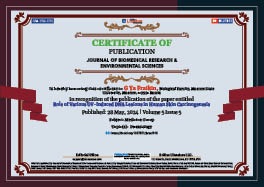G Ya Fraikin*
Volume5-Issue5
Dates: Received: 2024-05-11 | Accepted: 2024-05-21 | Published: 2024-05-28
Pages: 466-473
Abstract
FullText HTML
FullText PDF
DOI: 10.37871/jbres1916
Certificate of Publication

Copyright
© 2024 Fraikin GY. Distributed under Creative Commons CC-BY 4.0
How to cite this article
Fraikin GY. Role of Various UV-Induced DNA Lesions in Human Skin Carcinogenesis. J Biomed Res Environ Sci. 2024 May 28; 5(5): 466-473. doi: 10.37871/jbres1916, Article ID: JBRES1916, Available at: https://www.jelsciences.com/articles/ jbres1916.pdf
Subject area(s)
References
- Pfeifer GP, Besaratinia A. UV wavelength-dependent DNA damage and human non-melanoma and melanoma skin cancer. Photochem Photobiol Sci. 2012 Jan;11(1):90-7. doi: 10.1039/c1pp05144j. Epub 2011 Aug 1. PMID: 21804977; PMCID: PMC3289542.
- Fraikin GY. Signaling Mechanisms Regulating Diverse Plant Cell Responses to UVB Radiation. Biochemistry (Mosc). 2018 Jul;83(7):787-794. doi: 10.1134/S0006297918070027. PMID: 30200863.
- Cadet J , Douki T . Formation of UV-induced DNA damage contributing to skin cancer development. Photochem Photobiol Sci. 2018 Dec 5;17(12):1816-1841. doi: 10.1039/c7pp00395a. PMID: 29405222.
- Fraikin G Ya, Belenikina NS, Rubin AB. Photochemical processes of cell DNA damage by UV radiation of various wavelengths: biological consequences. Mol Biol. 2024;58:1-16. doi: 10.1134/s0026893324010047.
- Baptista MS, Cadet J, Greer A, Thomas AH. Photosensitization Reactions of Biomolecules: Definition, Targets and Mechanisms. Photochem Photobiol. 2021 Nov;97(6):1456-1483. doi: 10.1111/php.13470. Epub 2021 Jul 8. PMID: 34133762.
- Lorente C, Serrano MP, Vignoni M, Dantola ML, Thomas AH. A model to understand type I oxidations of biomolecules photosensitized by pterins. J Photochem Photobiol. 2021;7:100045. doi: 10.1016/j.jpap.2021.100045.
- Estebanez S, Lorente C, Tosato MG, Miranda MA, Marin ML, Lhiaubet-Vallet V, Thomas AH. Photochemical formation of a fluorescent thymidine-pterin adduct in DNA. Dyes Pigments. 2019;160:624-632. doi: 10.1016/j.dyepig.2018.08.024.
- Vechtomova YL, Telegina TA, Kritsky MS. Evolution of Proteins of the DNA Photolyase/Cryptochrome Family. Biochemistry (Mosc). 2020 Jan;85(Suppl 1):S131-S153. doi: 10.1134/S0006297920140072. PMID: 32087057.
- Zhang M, Wang L, Zhong D. Photolyase: Dynamics and electron-transfer mechanisms of DNA repair. Arch Biochem Biophys. 2017 Oct 15;632:158-174. doi: 10.1016/j.abb.2017.08.007. Epub 2017 Aug 9. PMID: 28802828; PMCID: PMC5650541.
- Xu J, Lahiri I, Wang W, Wier A, Cianfrocco MA, Chong J, Hare AA, Dervan PB, DiMaio F, Leschziner AE, Wang D. Structural basis for the initiation of eukaryotic transcription-coupled DNA repair. Nature. 2017 Nov 30;551(7682):653-657. doi: 10.1038/nature24658. Epub 2017 Nov 22. PMID: 29168508; PMCID: PMC5907806.
- Mei Kwei JS, Kuraoka I, Horibata K, Ubukata M, Kobatake E, Iwai S, Handa H, Tanaka K. Blockage of RNA polymerase II at a cyclobutane pyrimidine dimer and 6-4 photoproduct. Biochem Biophys Res Commun. 2004 Aug 6;320(4):1133-8. doi: 10.1016/j.bbrc.2004.06.066. PMID: 15249207.
- Brueckner F, Hennecke U, Carell T, Cramer P. CPD damage recognition by transcribing RNA polymerase II. Science. 2007 Feb 9;315(5813):859-62. doi: 10.1126/science.1135400. PMID: 17290000.
- Walmacq C, Cheung AC, Kireeva ML, Lubkowska L, Ye C, Gotte D, Strathern JN, Carell T, Cramer P, Kashlev M. Mechanism of translesion transcription by RNA polymerase II and its role in cellular resistance to DNA damage. Mol Cell. 2012 Apr 13;46(1):18-29. doi: 10.1016/j.molcel.2012.02.006. Epub 2012 Mar 8. PMID: 22405652; PMCID: PMC3329276.
- Selby CP, Lindsey-Boltz LA, Li W, Sancar A. Molecular Mechanisms of Transcription-Coupled Repair. Annu Rev Biochem. 2023 Jun 20;92:115-144. doi: 10.1146/annurev-biochem-041522-034232. Epub 2023 Mar 31. PMID: 37001137.
- Panigrahi A, Vemuri H, Aggarwal M, Pitta K, Krishnan M. Sequence specificity, energetics and mechanism of mismatch recognition by DNA damage sensing protein Rad4/XPC. Nucleic Acids Res. 2020 Mar 18;48(5):2246-2257. doi: 10.1093/nar/gkaa078. PMID: 32047903; PMCID: PMC7049735.
- Johann To Berens P, Molinier J. Formation and Recognition of UV-Induced DNA Damage within Genome Complexity. Int J Mol Sci. 2020 Sep 12;21(18):6689. doi: 10.3390/ijms21186689. PMID: 32932704; PMCID: PMC7555853.
- Tewari A, Grage MM, Harrison GI, Sarkany R, Young AR. UVA1 is skin deep: molecular and clinical implications. Photochem Photobiol Sci. 2013 Jan;12(1):95-103. doi: 10.1039/c2pp25323b. PMID: 23192740.
- Halliday GM, Cadet J. It's all about position: the basal layer of human epidermis is particularly susceptible to different types of sunlight-induced DNA damage. J Invest Dermatol. 2012 Feb;132(2):265-7. doi: 10.1038/jid.2011.281. PMID: 22241442.
- Delinasios GJ, Karbaschi M, Cooke MS, Young AR. Vitamin E inhibits the UVA1 induction of “light” and “dark” cyclobutane pyrimidine dimers, and oxidatively generated DNA damage, in keratinocytes. Sci Rep. 2018;8:423.
- Lawrence KP, Douki T, Sarkany RPE, Acker S, Herzog B, Young AR. The UV/Visible radiation boundary region (385-405 nm) damages skin cells and induces “dark” cyclobutane pyrimidine dimers in human skin in vivo. Science. 2018;8:12722.
- Mouret S, Forestier A, Douki T. The specificity of UVA-induced DNA damage in human melanocytes. Photochem Photobiol Sci. 2012 Jan;11(1):155-62. doi: 10.1039/c1pp05185g. Epub 2011 Oct 10. PMID: 21986862.
- Noonan FP, Zaidi MR, Wolnicka-Glubisz A, Anver MR, Bahn J, Wielgus A, Cadet J, Douki T, Mouret S, Tucker MA, Popratiloff A, Merlino G, De Fabo EC. Melanoma induction by ultraviolet A but not ultraviolet B radiation requires melanin pigment. Nat Commun. 2012 Jun 6;3:884. doi: 10.1038/ncomms1893. PMID: 22673911; PMCID: PMC3621412.
- Premi S, Wallisch S, Mano CM, Weiner AB, Bacchiocchi A, Wakamatsu K, Bechara EJ, Halaban R, Douki T, Brash DE. Photochemistry. Chemiexcitation of melanin derivatives induces DNA photoproducts long after UV exposure. Science. 2015 Feb 20;347(6224):842-7. doi: 10.1126/science.1256022. PMID: 25700512; PMCID: PMC4432913.
- Premi S, Brash DE. Unanticipated role of melanin in causing carcinogenic cyclobutane pyrimidine dimmers. Mol Cell Oncol. 2015 Jun 23;3(1):e1033588. doi: 10.1080/23723556.2015.1033588. Erratum in: Mol Cell Oncol. 2016 Jul;3(4):e1198570. PMID: 27308551; PMCID: PMC4845191.
- Premi S, Brash DE. Chemical excitation of electrons: A dark path to melanoma. DNA Repair (Amst). 2016 Aug;44:169-177. doi: 10.1016/j.dnarep.2016.05.023. Epub 2016 Jun 1. PMID: 27262612; PMCID: PMC4958542.
- Fajuyigbe D, Douki T, van Dijk A, Sarkany RPE, Young AR. Dark cyclobutane pyrimidine dimers are formed in the epidermis of Fitzpatrick skin types I/II and VI in vivo after exposure to solar-simulated radiation. Pigment Cell Melanoma Res. 2021 May;34(3):575-584. doi: 10.1111/pcmr.12956. Epub 2021 Jan 20. PMID: 33369222.
- Wondrak GT, Jacobson MK, Jacobson EL. Endogenous UVA-photosensitizers: mediators of skin photodamage and novel targets for skin photoprotection. Photochem Photobiol Sci. 2006 Feb;5(2):215-37. doi: 10.1039/b504573h. Epub 2005 Aug 19. PMID: 16465308.






























































